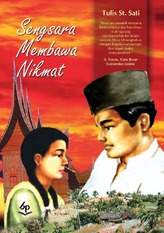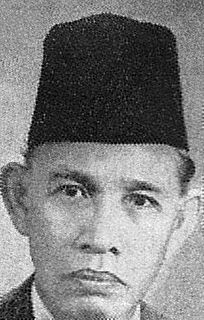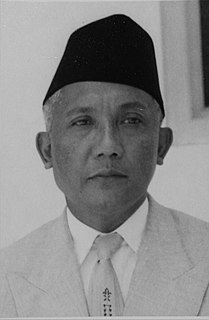Related Research Articles

Minangkabau people, also known as Minang, are an ethnic group native to the Minangkabau Highlands of West Sumatra, Indonesia. The Minangkabau's West Sumatran homelands was the seat of the Pagaruyung Kingdom, believed by early orientalists to have been the cradle of the Malay race, and the location of the Padri War.

Djamaluddin Adinegoro was an Indonesian press pioneer. He is known as a reporter, writer, and political analyst. Through his writing in various newspapers, Adinegoro has made a great contribution in developing journalism and the Indonesian language. His name was immortalized as a journalism award in Indonesia: the Adinegoro Award. Djamaluddin was a younger half-brother of Muhammad Yamin.

Prof. Dr. H. Abdul Malik Karim Amrullah, better known by the pen name Hamka was an Indonesian ʿālim, philosopher, writer, lecturer, politician and journalist.

Indonesian literature is a term grouping various genres of South-East Asian literature.
The Salakanagara Kingdom is the first historically recorded Indianised kingdom in Western Java The kingdom existed between 130-362 AD. A relatively modern literature in the 17th century Pustaka Rajya Rajya i Bhumi Nusantara describes Salakanagara as being founded by an Indian merchant. However no historical records affirms this modern writeup on the ancient kingdom.
Ali Akbar Navis was a prominent Indonesian author, poet and humorist.

Sengsara Membawa Nikmat is an Indonesian novel written by Tulis Sutan Sati. It was published in 1929 by Balai Pustaka. It tells the story of Midun, the son of a farmer, who experiences many trials before finally living happily with his new wife. It has been noted as one of Sati's most interesting works.
Siamang putih is the name of an Indonesian folk legend. In this legend, a princess promises that she will wait for her fiancé. After years of waiting for his return, she breaks her promise and is cursed to live out her live as a white siamang. This folktale is also known from the Malay Peninsula, where siamangs occur as well.
Cindelaras is a figure of East Java folklore. The son of Raden Putra, his mother was exiled from Janggala Kingdom. She gave birth to a young boy who had a really good rooster. That rooster killed all the other roosters, the end.
Putri Tangguk is a character from Jambi folklore. According to the story, Putri Tangguk is a mother who has seven kids and lives with her husband. Her husband and she are both farmers. Although they work hard to take care of their children, Putri Tangguk realizes that she does not have much time for her children due to her tiring work. One day, Putri Tangguk tells her husband about a plan she forms, filling up their warehouse with rice and other supplies so that they will not have to work as much or as long. They do this, and on a rainy day, Putri Tangguk walks with her family to the rice field after the sky clears. Suddenly, she slips on the wet ground. She becomes angry at the road and curses it. Nonetheless, they continue on to the rice fields. On their return home, they walk along the same road. Putri Tangguk sows a rice paddy on that road so that it will not ever be slippery again. However, she quickly regrets this act after she realizes that the rice paddy is important. The lesson of the story is to be thankful for what one has.
Dayang Bandir and Sandean Raja is Simalungun folklore that located at Sumatera Utara. Dayang Bandir and Sandean Raja are brother and sister. Seven years after Dayang Bandir is born, their parents die. Dayang Bandir's and Sandean Raja's father is a king that ruled the eastern kingdom. They live with their uncle named Kareang. They have another uncle that ruled the western kingdom named Raja Soma. Sandean Raja is the successor of the eastern kingdom after his father died. But, Sandean Raja is too young to be a king. So Kareang replaces Sandean Raja's position until he is old enough to be king. Kareang is ambitious to be king but he needs eastern kingdom heirlooms to claim the king position from Sandean Raja. Dayang Bandir knows his uncle's ambition so she hides the eastern kingdom heirlooms. Kareang is really angry because of what Dayang Bandir has done. He takes Dayang Bandir and Sandean Raja to the forest and kills Dayang Bandir by hanging Dayang Bandir's body at a tree in the middle of the forest. After that, Kareang leaves the bodies of Dayang Bandir and Sandean Raja in forest. Sandean Raja succeeds in getting out from the forest and he goes to the western kingdom. In the western kingdom, Sandean Raja has been kept by Raja Soma. He marries Raja Soma's Daughter. After a few years, Sandean Raja attacks Kareang kingdom and ruled Eastern Kingdom and Western Kingdom.
Puti Bungsu is the name of the character that is found in the story of the Minangkabau people of West Sumatra. Puti Bungsu, according to local folklore, is one of seven daughters who came from the sky. Puti, the youngest character in the folklore of West Sumatra, is also called the daughter who fell from the sky, along with one of the king's wives.

Rangkiang is a granary or rice barn of the Minangkabau people used to keep rice. The rangkiang is a distinctive feature of Minangkabau architecture. The structure is traditionally found in the courtyard of a rumah gadang, the traditional house of Minangkabau people.

Mahmud Yunus was an Indonesian Minangkabau Islamic preacher and teacher. He authored over seventy-five books, including Tafsir Qur'an Karim and an Arab-Indonesian dictionary. His books are used in madarsas and pesantrens. During his employment in the Indonesian Department of Religion, he promoted the incorporation of religious lessons into the national education curriculum. Yunus received an Honorary Doctorate in "tarbiyah" from IAIN Syarif Hidayatullah, Jakarta. A road to IAIN Imam Bonjol, Padang is named after him.
Tuanku Rao (1790-1833) was an Islamic cleric (ulama), leader and commander. He was known as a prominent padri, a group of Islamic reformists who advocated for the puritanical approach in Islam inspired by Muhammad ibn Abd al-Wahhab in the early 18th century West Sumatra. He also contributed to the proselytization of Islam among Batak people. He died during the Padri War in 1833.
Persatuan Muslim Indonesia, also abbreviated as PERMI, was a political party espoused Islamic-nationalism based in Padang Panjang, founded in 1930. The party was dissolved due to the crackdown by the Dutch East Indies colonial government in 1937. PERMI is regarded as a political party active against the colonial repression by the Dutch. Unlike other political parties, PERMI was unique in its embracing of both political Islam and nationalism and placed them two in a parallel position.
In Pahang Malay folklore, Walinong Sari was a legendary princess of Inderapura renowned for her beauty and fighting skills. The tale of the princess was immortalized in a folk song named after her.

Kaharuddin Nasution was an Indonesian military official, diplomat, and former Governor of Riau from 1960 to 1966 and Governor of North Sumatra from 1983 to 1988.

Eny Karim, also spelled as Eni Karim, was an Indonesian politician and civil servant from West Sumatra who served as Minister of Agriculture under the Second Ali Sastroamidjojo Cabinet, and briefly as governor of North Sumatra in 1963.